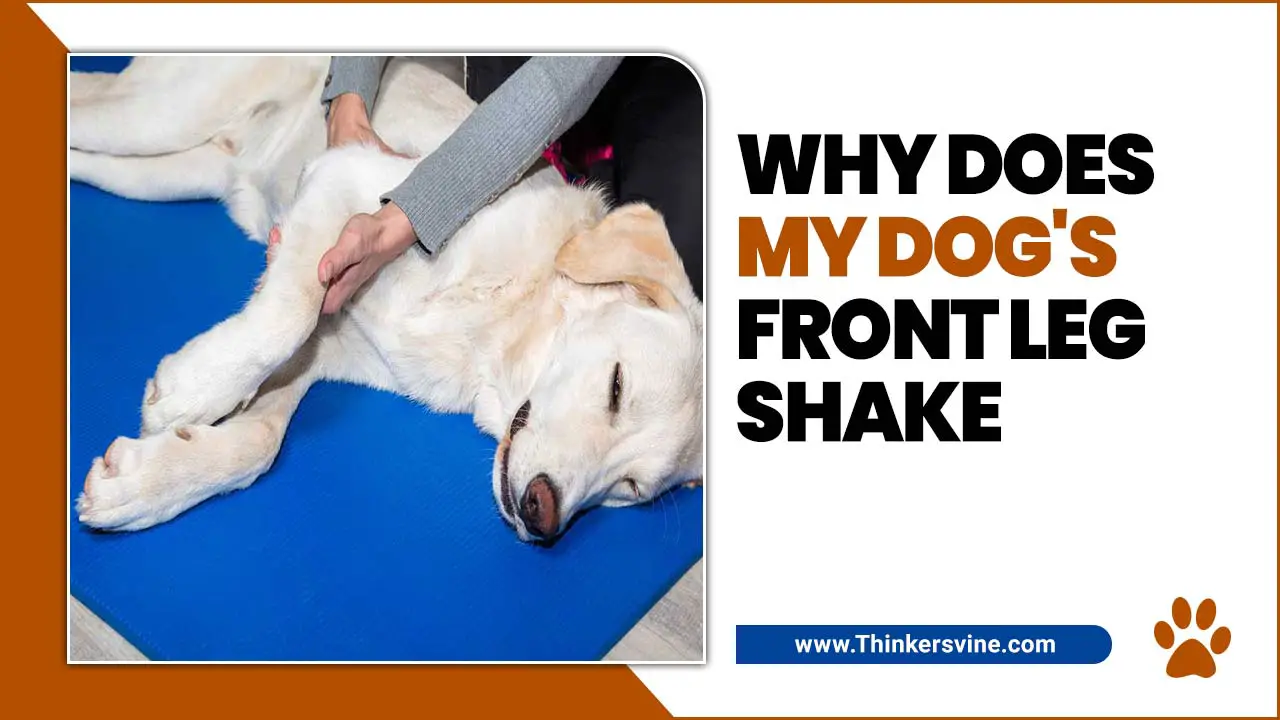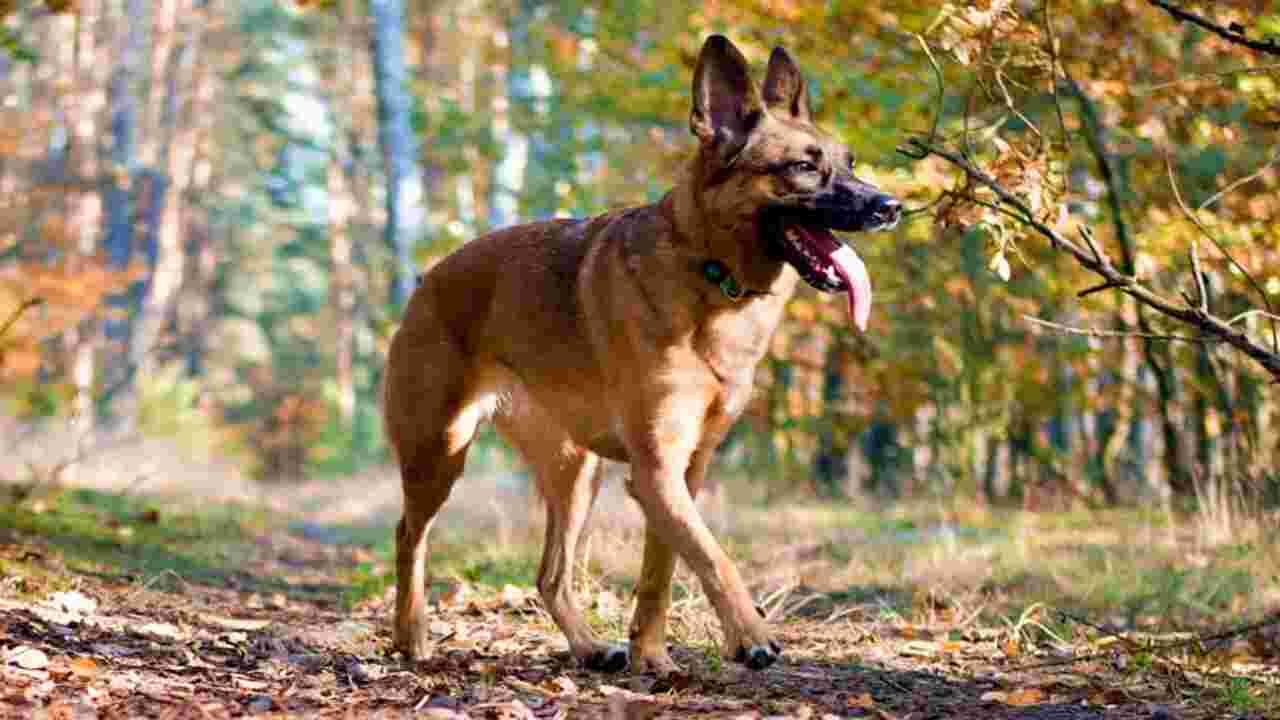Dogs are beloved companions that bring joy and comfort into our lives. They are often called man’s best friend, and it’s no wonder why. Dogs are loyal, affectionate, and possess an endless amount of energy.
However, like any living being, they, too, can experience various health issues. One common concern pet owners may have is when their dog’s front leg begins to shake. This can cause concern and may leave dog owners wondering what could be causing this unusual behavior.
As a responsible pet owner, it’s important to understand the reasons behind why does my dog’s front leg shake. We will delve into the different factors that can contribute to this behavior and provide insights on how to address and manage it. By understanding the possible causes of your dog’s leg shaking, you can ensure their overall health and well-being and strengthen the bond between you and your furry companion.

10 Reasons Why Does My Dog’s Front Leg Shake
A dog’s shaking leg may indicate any of these conditions. Some dogs may shake their front legs due to pain or injury. Dogs with arthritis, leg injuries, arthritis, hip dysplasia, or other joint issues may experience shaking legs due to pain.
Dogs with shivering syndrome, seizure disorder, and hypothermia may also experience shaking legs as a result of nervous system issues dog’s front leg may also shake when it is cold. Cold weather can lead to trembling and shivering in dogs. This can cause them to pace back and forth or shake their legs out of nervousness.
Dogs without an underlying disease condition that causes trembling or shivering can also experience this symptom due to anxiety. Also, dogs with heart disease could experience tremors due to an underlying condition causing muscle weakness or tremors. Elbow dysplasia is another possible cause of shivering legs in puppies.
Dogs with elbow dysplasia may have trembling legs due to the condition causing weakness in the front legs and loss of coordination. The condition is most commonly seen in puppies between 6 months to 3 years old and develops gradually over time. It is considered a hereditary disorder and involves abnormal development or malformation of the bones forming the elbow joint.
1.Stress

Dogs can become stressed and anxious due to changes in their environment, such as riding in a car or visiting the vet. The stress of these changes can lead to trembling, shaking, or other bad behaviors, such as chewing on furniture.
To help dogs cope with stress, it’s important to identify and alter the stress’s root causes. For example, avoid taking dogs on long car rides or visits to the vet and try to minimize stressful situations in the dog’s life. Veterinarians may also prescribe medications to help manage stress in dogs.
To reduce anxiety in dogs, providing adequate exercise and stimulation is vital. Dogs kept indoors most of the day tend to develop behavioural issues due to their lack of exercise and socialization with other animals and humans. So, you must care for your dog’s needs by providing them with daily walks and playing games.
2.Feeling Cold

Cold weather can cause dogs’ front legs to shake. Dogs may shake their front legs in response to feeling cold. Dogs exhibit this behavior when exposed to low temperatures for an extended period.
Cold temperatures hurt a dog’s body, leading to leg shaking. Shaking can be caused by the dog’s body trying to generate heat to keep itself warm. When dogs tremble from cold exposure, it is usually a sign of discomfort and discomfort. Dogs start to tremble when exposed to cold temperatures for a long period.
3.Natural Response To Different Emotions
Dogs often shake their legs out of excitement and joy. Anxiety and fear can trigger physical responses such as shaking in dogs. Pain, tremors, and poisoning can cause front leg shaking in puppies. Factors such as mistreatment, abuse, or neglect can lead to a puppy trembling out of fear.
When excited, dogs may also shake their front legs to cool down or to calm down after a bout of hyperactivity. Loud noises, such as fireworks, can make puppies anxious, shaking the front leg. This natural behavior allows puppies to release excess energy or stress without harm to themselves or others.
4.Obesity
Obesity can lead to front leg shaking in dogs due to increased strain and pressure on the legs. Excess weight can cause pain, discomfort, and inflammation in the joints, resulting in shaking of the front legs. Overweight dogs are more likely to develop conditions such as elbow dysplasia, a common cause of front leg shaking.
Overweight dogs are also more likely to suffer from fatigue quickly, which can cause their legs to shake. These factors combine to create an unsteady gait and leg shakes that may be hard for owners to detect. While there is a range of reasons why a dog’s front legs may occasionally tremble, obesity is a common contributing factor.
5.Being Underweight

Underweight puppies may shake their front legs due to low energy levels and muscle weakness. While puppies may also shake their legs for other reasons, such as anxiety or discomfort, shaking the front legs is most likely caused by poor nutrition and low body weight.
Underweight dogs may also experience joint pain, which can cause trembling in the front legs. It would help if you cared for underweight dogs to ensure they get the nutrients they need to develop and thrive. This can help reduce the risk of shaking in puppies and ultimately lead to a healthier, happier dog.
6.Physical Injury

Physical injury is one of the dogs’ most common causes of front leg shaking. Also, physical injuries such as elbow dysplasia, common in puppies, can cause extreme pain and tremble in the front legs. Other common physical injuries leading to front leg shaking include broken bones and tumors.
When a dog has a physical injury, it is essential to consult a veterinarian for diagnosis and treatment. Severe physical injuries can also affect the nervous system and cause shaking in the front legs. Giving your dog rest and plenty of exercise is important to prevent shaking from physical injuries.
7.Shaking Puppy Syndrome
Shaking Puppy shaker syndrome (SPS) is a neurological disorder affecting dogs’ nervous systems. People most commonly see it in puppies between two weeks and three months. Common symptoms of SPS include trembling in one area or the entire body. The shaking may be sudden or may occur slowly over time. It can be acute or chronic and can sometimes be intermittent.
Puppies with SPS may also have difficulty walking, sitting, or sleeping normally. It is important to note that not all dogs with SPS will exhibit all of these symptoms. Additionally, some dogs with SPS will show no signs of the disorder. Certain dog breeds are more likely to develop SPS than others, and the dog’s parents typically inherit this condition.
8.Nervous System Conditions
Nervous system conditions can affect dogs of all ages and breeds. Some common nervous system chronic conditions are infection, brain haemorrhages, seizures, and tumors. In some cases, dogs may have subtle neurological Additional signs that go unnoticed until a diagnosis is made.
Other symptoms may include fever, confusion or disorientation, and loss of coordination. Whether it’s neurological symptoms or twitching caused by extreme discomfort caused by a slipped disc or nerve problem, nervous system issues can be difficult to diagnose in dogs and require a thorough workup to determine the cause and treatment options.
9.Arthritis
Arthritis is a common cause of dog shaking while sitting. Osteoarthritis, or “degenerative joint Nervous system disease,” is the most common type of arthritis and causes heart pain and inflammation in the dog’s joints. Other forms of arthritis can also lead to shaking in dogs.
Hip dysplasia, a condition in which the hip socket develops abnormally, can cause lameness and arthritis of the joints, leading to a dog’s front legs shaking instead of its back hind legs. Hip dysplasia may also cause dogs to use their front legs more often, resulting in muscle loss and difficulty standing. In severe cases, dogs may be unable to walk at all.
Hip dysplasia is one of the dogs’ most common genetic disorders and can lead to serious health issues if not treated early on. If you notice your dog shaking its front legs while sitting down or standing up, it may suffer from arthritis or some other form of health problem. It’s important to take your dog to a veterinarian as soon as possible for diagnosis and treatment.
10.Panosteitis

Panosteitis is a Kidney disease of the bones and joints of dogs that can cause sudden lameness and pain. This disorder affects puppies most frequently between 2 and 4 months old. Other symptoms of panosteitis include shaking of the front leg, trembling, and walking with a wobbly gait.
In cases of severe disease, puppies may exhibit trembling legs, reluctance to move from one place to another, or difficulty standing or walking. Diagnosis of panosteitis typically involves an X-ray examination and a history of sudden lameness. Give high-quality, palatable food and limit exercise time to support your excellent puppy food with panosteitis.
Treatment Of Involuntary Muscle Trembling In Dogs
When your dog’s front leg shakes involuntarily, it can be concerning. This trembling may sometimes be a symptom of an underlying medical condition or injury. It is important to consult with a veterinarian to diagnose the cause of the tremors and determine the appropriate treatment.
Treatment options for involuntary muscle trembling in dogs may vary depending on the underlying cause but may include medication, physical therapy, or lifestyle changes. It’s crucial to provide your furry friend the care they need to alleviate their discomfort and improve their overall well-being.
Recovery Of Involuntary Muscle Trembling In Dogs

Involuntary muscle trembling in a dog’s front leg can cause concern for many pet owners. The good news is that, in most cases, these tremors are temporary and can be attributed to various factors. One common cause is muscle fatigue or overexertion, especially after intense exercise or play.
Another possible cause is anxiety or stress, which can manifest as trembling in the front leg. In some cases, generalized tremor syndrome may also be a symptom of an underlying medical condition such as arthritis or neurological issues.
If you notice persistent or worsening muscle tremors, it is important to consult with your veterinarian to determine the underlying cause and develop an appropriate treatment plan. With proper care and management, dogs can recover from involuntary muscle trembling and lead happy, healthy lives.
When To Seek Veterinary Help For Your Dog’s Leg Shaking

If you notice your dog’s front leg starting to shake, you must get them to the vet as soon as possible. Look for any accompanying symptoms, such as vomiting, bloating, labored breathing, ataxia, or lethargy, which could indicate a serious and potentially life-threatening condition.
Your vet will conduct a thorough neurological condition and orthopaedic examination and may prescribe further tests, such as blood sugar pressure tests or limb X-rays, based on the findings. If your dog’s leg shaking is due to nervousness, nausea, or pain, you can treat it at home by distracting them with toys or treats. However, consult your vet if you notice any worsening symptoms or if your dog’s shaking becomes constant.
Conclusion
Your dog’s leg shaking is not a life-threatening condition. However, it can be distressing, and you should seek veterinary help if the shaking persists or worsens. A vet can decide on the best course of action depending on your dog’s symptoms and health history when facing an emergency that requires immediate attention.
Leg shaking is a common side effect of nervous system conditions that impact dogs’ legs. It’s important to remember that shaking can be a temporary or long-term problem and that you can treat most of these conditions successfully with the help of your vet. We’ve discussed why does my dog’s front leg shake. If you notice any changes in your dog’s leg shaking, it’s best to consult an expert for diagnosis and treatment.
Frequently Asked Questions
[rank_math_rich_snippet id=”s-f68962fd-ac47-41ef-88ba-5277f133e331″]